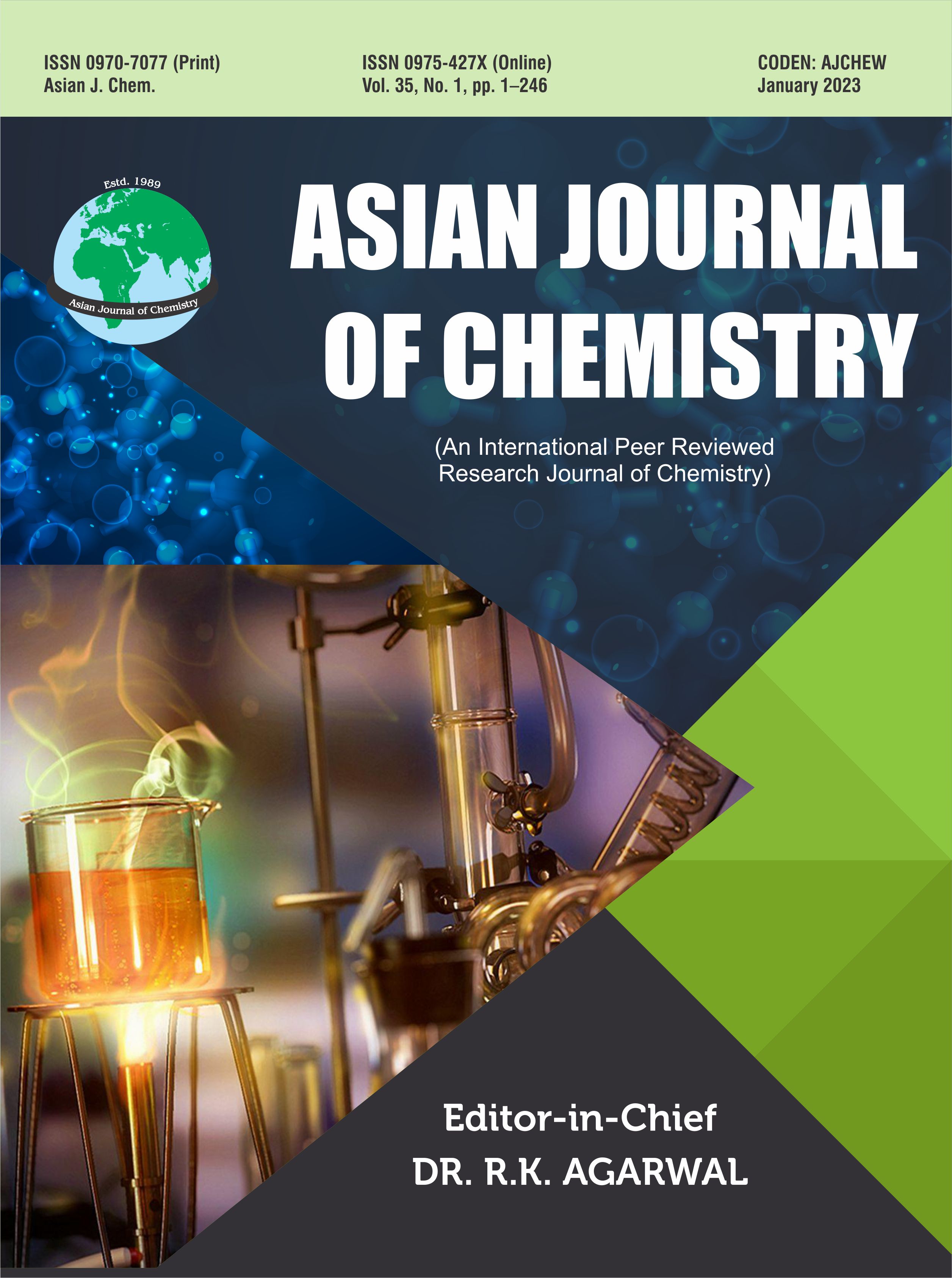Copyright (c) 2023 AJC

This work is licensed under a Creative Commons Attribution 4.0 International License.
Development of Efficient Manufacturing Process for Active Pharmaceutical Ingredient Epalrestat and its Derivatives in Continuous Flow Synthesis
Corresponding Author(s) : G. Veera Raghava Sharma
Asian Journal of Chemistry,
Vol. 35 No. 1 (2023): Vol 35 Issue 1
Abstract
An effective method for synthesis of the active pharmaceutical ingredient epalrestat in continuous or tubular flow circumstances with a high yield and a quick reaction time (10 min) has been reported. The reaction conditions for the aldol condensation reaction under tubular continuous flow technology by controlling light-sensitive degradation impurities was optimized. The developed method was more efficient, environmentally benign, time-economic, energy-saving, cost-efficient and also gives a reduction in process mass intensity in comparison with batch process.
Keywords
Download Citation
Endnote/Zotero/Mendeley (RIS)BibTeX
- J. He, H.-X, Gao, N. Yang, X.-D. Zhu, R.-B. Sun, Y. Xie, C.-H. Zeng, J.-W. Zhang, J.-K. Wang, F. Ding, J.-Y. Aa and G.-J. Wang, Acta Pharmacol. Sin., 40, 86 (2019); https://doi.org/10.1038/s41401-018-0043-5
- L. Quattrini an M.C. La, Expert Opin. Ther. Pat., 29, 199 (2019); https://doi.org/10.1080/13543776.2019.1582646
- T. Tanouchi, M. Kawamura, A. Ajima, T. Mohri, M. Hayashi, H. Terashima, F. Hirata and T. Morimura, Rhodanine Derivatives, Process for their Preparation and Aldose Reductase Inhibitor containing the Rhodanine Derivatives as Active Gradient, US Patent 4464382A (1981).
- A.R. Bogdan and A.W. Dombrowski, J. Med. Chem., 62, 6422 (2019); https://doi.org/10.1021/acs.jmedchem.8b01760
- T.L. LaPorte, L. Spangler, M. Hamedi, P. Lobben, S.H. Chan, J. Muslehiddinoglu and S.S.Y. Wang, Org. Process Res. Dev., 18, 1492 (2014); https://doi.org/10.1021/op500176z
- J.P. McMullen, C.H. Marton, B.D. Sherry, G. Spencer, J. Kukura and N.S. Eyke, Org. Process Res. Dev., 22, 1208 (2018); https://doi.org/10.1021/acs.oprd.8b00192
- C. Hu, J. Flow Chem., 11, 243 (2021); https://doi.org/10.1007/s41981-021-00164-3
- A.R. Bogdan and A.W. Dombrowski, J. Med. Chem., 62, 6422 (2019); https://doi.org/10.1021/acs.jmedchem.8b01760
- S.L. Lee, T.F. O’Connor, X. Yang, S. Chatterjee, R.D. Madurawe, C.N. Cruz, C.M.V. Moore, L.X. Yu and J. Woodcock, J. Pharm. Innov., 10, 191 (2015); https://doi.org/10.1007/s12247-015-9215-8
- L. Zhou, S. Martin, W. Cheng, L. Lassabatere, J.-F. Boily and K. Hanna, Environ. Sci. Technol., 53, 10102 (2019); https://doi.org/10.1021/acs.est.9b03214
- M. Sun, J. Yang, Y. Fu, C. Liang, H. Li, G. Yan, C. Yin, W. Yu, Y. Ma, R. Cheng and J. Ye, Org. Process Res. Dev., 25, 1160 (2021); https://doi.org/10.1021/acs.oprd.0c00543
- B. Halford, C&EN, 95, 7 (2017); https://doi.org/10.1021/cen-09525-notw2
- M. Michida, H. Ishikawa, T. Kaneda, S. Tatekabe and Y. Nakamura, Org. Process Res. Dev., 23, 524 (2019); https://doi.org/10.1021/acs.oprd.8b00413
References
J. He, H.-X, Gao, N. Yang, X.-D. Zhu, R.-B. Sun, Y. Xie, C.-H. Zeng, J.-W. Zhang, J.-K. Wang, F. Ding, J.-Y. Aa and G.-J. Wang, Acta Pharmacol. Sin., 40, 86 (2019); https://doi.org/10.1038/s41401-018-0043-5
L. Quattrini an M.C. La, Expert Opin. Ther. Pat., 29, 199 (2019); https://doi.org/10.1080/13543776.2019.1582646
T. Tanouchi, M. Kawamura, A. Ajima, T. Mohri, M. Hayashi, H. Terashima, F. Hirata and T. Morimura, Rhodanine Derivatives, Process for their Preparation and Aldose Reductase Inhibitor containing the Rhodanine Derivatives as Active Gradient, US Patent 4464382A (1981).
A.R. Bogdan and A.W. Dombrowski, J. Med. Chem., 62, 6422 (2019); https://doi.org/10.1021/acs.jmedchem.8b01760
T.L. LaPorte, L. Spangler, M. Hamedi, P. Lobben, S.H. Chan, J. Muslehiddinoglu and S.S.Y. Wang, Org. Process Res. Dev., 18, 1492 (2014); https://doi.org/10.1021/op500176z
J.P. McMullen, C.H. Marton, B.D. Sherry, G. Spencer, J. Kukura and N.S. Eyke, Org. Process Res. Dev., 22, 1208 (2018); https://doi.org/10.1021/acs.oprd.8b00192
C. Hu, J. Flow Chem., 11, 243 (2021); https://doi.org/10.1007/s41981-021-00164-3
A.R. Bogdan and A.W. Dombrowski, J. Med. Chem., 62, 6422 (2019); https://doi.org/10.1021/acs.jmedchem.8b01760
S.L. Lee, T.F. O’Connor, X. Yang, S. Chatterjee, R.D. Madurawe, C.N. Cruz, C.M.V. Moore, L.X. Yu and J. Woodcock, J. Pharm. Innov., 10, 191 (2015); https://doi.org/10.1007/s12247-015-9215-8
L. Zhou, S. Martin, W. Cheng, L. Lassabatere, J.-F. Boily and K. Hanna, Environ. Sci. Technol., 53, 10102 (2019); https://doi.org/10.1021/acs.est.9b03214
M. Sun, J. Yang, Y. Fu, C. Liang, H. Li, G. Yan, C. Yin, W. Yu, Y. Ma, R. Cheng and J. Ye, Org. Process Res. Dev., 25, 1160 (2021); https://doi.org/10.1021/acs.oprd.0c00543
B. Halford, C&EN, 95, 7 (2017); https://doi.org/10.1021/cen-09525-notw2
M. Michida, H. Ishikawa, T. Kaneda, S. Tatekabe and Y. Nakamura, Org. Process Res. Dev., 23, 524 (2019); https://doi.org/10.1021/acs.oprd.8b00413




